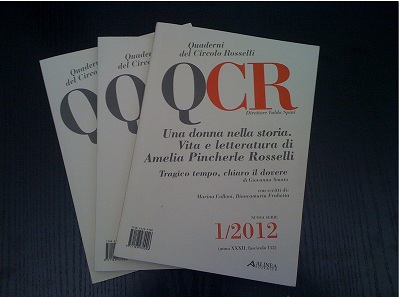In Bagnoles for the Rosselli*
by Valdo Spini, President of the Fondazione Circolo Rosselli
Bagnoles de l’Orne has changed. But not simply by the inevitable passage of time. This town in Normandy, with a population of about 2,600, is where the Cagoule assassinated brothers Carlo and Nello Rosselli, under the mandate of the fascist Italian government. Bagnoles has remained an important town because of its tourism industry and health system (Carlo Rosselli went there to cure his phlebitis), only the administrative disposition has changed. Most of the hotels (starting with the glorious Grand Hotel) have closed or become residences, the new normal. And so, the charming hotel of Carlo and Marion Rosselli had fallen. Then Nello built the Hotel Cordier, a building of Norman shape. It would be the most imposing Bel Air facing him and where the components of the Cagoule (a bloody terrorist organization of French right extremists who killed them materially) arrived from Paris to watch the movements. It was there still, but hopelessly closed. We photographed them, still with their names written on the respective buildings, because they remain intact.
And it was from the Hotel Cordier that the two brothers left on June 9, 1937, in a beat-up Ford used by Carlo in the Spanish Civil War, to bring Carlo’s wife Marion to the train station. She needed to return to Paris in time to celebrate her first-born’s birthday. They then headed to Alençon, under constant watch by the Cagoule, which organized the bloody ambush in the streets upon their return, a few miles from Bagnoles.
In Bagnoles, there are no touristy indications or road signs to draw attention to the presence of a commemorative monument put in at the site of the murder, but the memory remains, at least in older people. If you entered a boulangerie built close to the hamlet of Couterne and asked someone to show you to the monument, a woman waiting her turn to buy bread will point to the clients of a flower shop where you would then buy roses to deposit at the feet of the monument.
In addition to flowers, the principle bookstore sells, for those who wish to read themselves the history of l’Orne, a book about the territory. It tells of, with some inaccuracy but total solidarity, the victory of crime.
But we should not delude ourselves; time can fade these memories if we don’t revisit them.
We have retraced the street, now asphalt, once dirt, in the same direction as the Rosselli brothers, and a few kilometers from Bagnoles, we see the forest—the Cagoule’s choice for the theater of criminal action. Tricked into stopping their car, the brothers were both shot with a revolver and stabbed by a commando of the Cagoule who acted by direct mandate of the Military Information Service of the fascist Italian government.
As previously stated, no sign announces the monument. There is a hedge, cured in the shape of a horseshoe, open to the street. From here, walking above a colorful garden, one can access the monument and sculptures by Carlo Sergio Signori (1949). Within the ranks of Giustizia e Libertà (Justice and Liberty Party), the antifascist movement was founded and driven by Carlo Rosselli.
The monument is overall well maintained, neat, and clean. At your feet, two crowns symbolize the two fallen martyrs, paying tribute. I have seen the sketch of the monument, which, thanks to Nicòli di Carrara’s studio, will be exposed in the Spazio QCR for the 77th anniversary celebration on June 9th 2014. But it should be seen in context, in its position. My impression was intensely positive. The stems somehow represent something even more durable than the original image. With the background of the forest serving to frame the criminal ambush, it invites concentration, meditation, and awareness. A tremendous impression.
If cleaned to return legibility, the inscription on the top of the tallest stem reads (in French):
CARLO ET NELLO ROSSELLI
TOMBES ICI POUR LA JUSTICE
ET LA LIBERTE’
SOUS LE POIGNARD DE LA CAGUOLE
PAR ORDRE
DU REGIME FASCISTE
ITALIEN
The inscription does not need elaboration. We can parallel it to what Pierro Calamandrei wrote for their tomb in the cement of Trespiano (Florence): CARLO E NELLO ROSSELLI/GIUSTIZA E LIBERTA’/PER QUESTO VISSERO/PER QUESTO MORIRONO (Carlo and Nello Rosselli/Justice and Freedom/For this they lived/For this they died)
For us not to forget, we must recount and hand down their memory. To this end, we must dedicate more attention to this moment, now placed in the French earth, and ask if there are more indications, if there is more knowledge.
*Translation in english by Carlie Tetenbaum, Stanford University in Florence













Hurrah! In the end I got a website from where I know
how tto truly obtain useful information regarding my study and knowledge. https://Ukrain-Forum.Biz.ua/